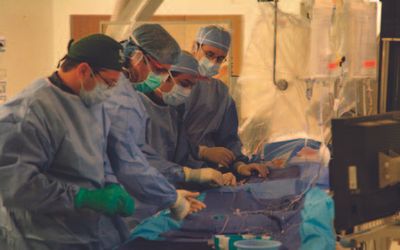Academics
With professors from the University at Buffalo (UB) Departments of Neurosurgery, Radiology & Biomedical Engineering, the Canon Stroke & Vascular Research Center is truly a multidisciplinary hub. The investigators in our lab provide mentorship to undergraduates, graduates, and doctoral students through our affiliation with UB and the Jacob's School of Medicine and Biomedical Sciences.
Research Fellows

The Endovascular Surgical Neuroradiology service at UB Neurosurgery and Kaleida Health is world-renowned for its innovation and advancements in minimally invasive treatments for neurological disorders.
In collaboration with a multi-disciplinary team of scientists at the acclaimed Canon Stroke & Vascular Research Center (CSVRC), the endovascular surgical neuroradiology faculty and fellows conduct “translational” research, which involves the rapid application of treatment breakthroughs in the clinical arena. In addition, the faculty and fellows participate in numerous national clinical trials. Thus, staying at the forefront of technology and treatment.
The research fellows are hand-selected by Dr. Adnan Siddiqui and are active in clinical trials and manuscript publication. They are instrumental liaisons between the Department of Neurosurgery and CSVRC. The fellows provide insight into current clinical practices, imaging interpretation and a wealth of anonymized data.

Past Graduates
Rupa De, Ph.D., 2000-2001
Chang-Ying Yang, Ph.D., 2000-2001
Ling Gao, Ph.D., 2005-2009
Department of Biomedical Engineering
Alex ME Podgorsak, Ph.D., 2015- 2021
Zeynab Rezaee Hassan Abadi, Ph.D., 2016-2021
Kelsey Sommer, Ph.D., 2019-2021
Ryan Rava, Ph.D., 2018-2022
Mohammad Mahdi Shiraz Bhurwani, Ph.D., 2018-2022
Department of Biophysics
P. Massoumzadeh, Ph.D., 1992-1999
Department of Electrical Engineering
Christos Keleshis, Ph.D., 2004-2009
Hidab Hamwi, Ph.D., 2006-2008
Sharma Prateek, Ph.D., 2007-2012
Bin Qu Ph. D., 2008-2011
Ying Huang, Ph.D., 2008-2011
Setlur S.N. Vasan, Ph.D., 2009-2014
Department of Physics
Chang-Ying Yang, Ph.D., 1996-2000
Ruijie Liu, Ph.D., 1996-2001
Daryl Nazareth, Ph.D., 1998-2004
Arundhuti Chattopadhyay Ganguly, Ph.D., 1998-2003
Anant Gopal, Ph.D., 1999-2005
Mustafa Cem Altunbas, Ph.D., 1999-2004
Ye (Mark) Wu, Ph.D., 2000-2005
Ciprian Ionita, Ph.D., 2000-2005
Iacovos (Jake) Kyprianou, Ph.D., 2001-2004
Andreea Dohatcu, Ph.D., 2003-2009
Girijesh Yadava, Ph.D., 2004-2007
Andrew Kuhls-Gilcrist, Ph.D., 2005-2010,
Vikas Patel, Ph.D., 2005-2009
Amit Jain, Ph.D., 2007-2010
Department of Physiology & Biophysics
Zhou (Iris) Wang, Ph.D., 1998-2004
Wei Yuan Wang, Ph.D., 2007-2011
Ashish Panse, Ph.D., 2008-2012
Vivek Singh, Ph.D., 2010-2014
Vijay Rana, Ph.D., 2010-2015
Brendan Loughran, , Ph.D., 2010-2014
Jason Spaans, M.S., Ph.D, 2010-2013
Jon Schmitt, Ph.D., 2009-2012
Raman Rana, Ph. D., 2012-2017
Sarath Vijayan, Ph.D., 2013-2017
Megan Russ, Ph.D., 2013-2017
Medical Physics Program
Xiong, Zhenu, Ph.D., 2014-2018
Alok Shankar, Ph.D., 2014-2019
Jordan Krebs, Ph.D., 2016-2020
Chao Guo, Ph.D., 2016-2020
Allison Shields, Ph.D., 2018-2021
Stephen Bhagroo, Ph.D., 2018-2021
Shen-Hsuan Sun, Ph.D., 2019-2021
Jacob Collins, Ph.D., 2018-2022
Johnathan Troville, Ph.D., 2017-2022
Kyle Williams, M.S., 2022-2025
Emily Vanderbilt, Ph.D., 2021-2025
Martina Orji, Ph.D., 2021-2025
Department of Mechanical & Aerospace Engineering
Chityala N. Ravishankar, Ph.D., 2002-2006
Ye Pu, Ph.D., 2002
Hussain Soeb Rangwalla, Ph.D., 2002-2007
Minsuok Kim, Ph.D., 2004-2007
Yiemeng Hoi, Ph.D., 2004-2008
Markus Tremmel, Ph.D., 2006-2009
Eleni Metaxa, Ph.D., 2008-2009
Jianping Xiang, Ph.D., 2012-2016
Department of Neuroscience
Jennifer Dolan, Ph.D., 2013-2014